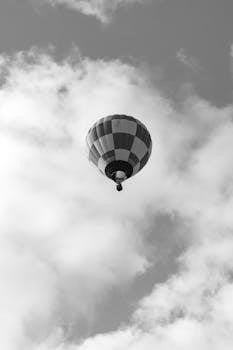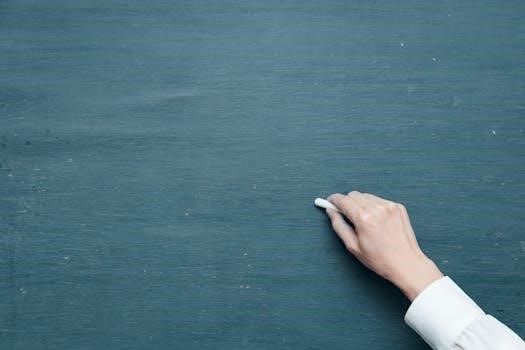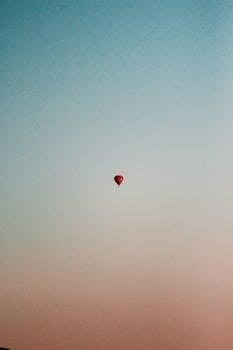Balloon Twisting Instructions PDF⁚ A Comprehensive Guide
Embark on a journey into the captivating realm of balloon artistry! This comprehensive guide is your gateway to crafting whimsical balloon creations. Whether you’re aiming to entertain at parties or discover a new hobby‚ our resources will elevate your skills‚ providing step-by-step tutorials.
Balloon twisting‚ also known as balloon modeling or balloon art‚ is the art of shaping balloons into various objects‚ often animals‚ characters‚ or abstract designs. It’s a delightful craft that combines creativity‚ dexterity‚ and a touch of whimsy‚ appealing to individuals of all ages. Balloon twisting has evolved from simple party entertainment to a sophisticated art form‚ with skilled twisters creating intricate and impressive sculptures.
The beauty of balloon twisting lies in its accessibility. With just a few balloons and a basic understanding of techniques‚ anyone can begin to create simple yet charming balloon figures. This introductory section will cover the fundamentals of balloon twisting‚ setting the stage for you to explore more complex designs and techniques in subsequent sections.

We’ll delve into the history and evolution of balloon twisting‚ exploring its origins and how it has transformed over time. You’ll also discover the diverse applications of balloon twisting‚ from entertaining children at birthday parties to creating eye-catching decorations for corporate events. Get ready to unlock your creative potential and embark on a fun-filled journey into the world of balloon twisting!
Essential Materials for Balloon Twisting
Before embarking on your balloon twisting adventure‚ it’s crucial to gather the necessary supplies. Having the right materials will not only make the process easier but also ensure better results. The most essential material is‚ of course‚ balloons! Specifically‚ you’ll need 260Q balloons‚ which are long‚ slender balloons designed for twisting. These balloons come in a variety of colors‚ allowing for endless creative possibilities.
Next‚ you’ll need a balloon pump. While it’s possible to inflate balloons manually‚ a pump will save you time and energy‚ especially when working with multiple balloons. Hand pumps and electric pumps are both viable options‚ depending on your preference and budget. A good pair of scissors or a cutting tool will also come in handy for trimming excess balloon material or creating specific shapes.
Additionally‚ consider investing in a balloon tying tool. These tools make tying balloon knots much easier and faster‚ especially for beginners. Finally‚ having a marker can be useful for adding details or facial features to your balloon creations. With these essential materials in hand‚ you’ll be well-equipped to start twisting and shaping balloons into amazing works of art!
Basic Balloon Twisting Techniques⁚ Bubbles and Twists
Mastering the fundamental techniques of bubbles and twists is essential for any aspiring balloon twister. These basic skills form the foundation upon which more complex creations are built. The “bubble” technique involves creating a small‚ round segment within the balloon by twisting it at specific points. To execute this‚ pinch the balloon with your finger and thumb at the desired location.
Then‚ carefully roll the rest of the balloon around that point‚ creating a distinct‚ rounded shape. The size of the bubble can be adjusted by varying the amount of balloon material used. Next‚ the “twist” is the most important part. To make a twist in the balloon‚ pinch the balloon with your finger and thumb at the place you want to create the twist. Then‚ roll the rest of the balloon around.
Practice these techniques diligently‚ experimenting with different sizes and combinations to develop your dexterity. Remember to always begin twisting at the knotted end of the balloon for stability. With consistent practice‚ you’ll be able to create a variety of shapes and patterns‚ paving the way for more elaborate balloon designs.
How to Inflate Balloons Properly
Properly inflating balloons is a crucial first step in balloon twisting‚ impacting the final shape and durability of your creation. Begin by selecting a high-quality balloon designed for twisting. These balloons are typically longer and more flexible than standard party balloons. Before inflation‚ stretch the balloon a few times to increase its elasticity and reduce the risk of bursting.
When inflating‚ use a balloon pump‚ either hand-operated or electric‚ for consistent and efficient results. Insert the pump nozzle into the balloon’s opening and hold it securely to prevent air leakage. Inflate the balloon to approximately 80-90% of its full capacity‚ leaving a small uninflated “tail.” This tail provides flexibility during twisting and prevents the balloon from popping. Avoid over-inflation‚ as it can weaken the balloon’s structure and make it more prone to breakage.
Once inflated‚ tie the balloon securely to prevent air from escaping. Practice inflating several balloons to develop a feel for the correct pressure and technique. This will help you avoid common problems and create balloon animals with a professional finish.
Making a Simple Balloon Dog⁚ Step-by-Step Instructions
Creating a balloon dog is a quintessential balloon twisting skill‚ perfect for beginners. Start with a fully inflated balloon‚ leaving about two inches uninflated at the end. This uninflated portion is crucial for maneuvering during the twisting process and preventing pops;
First‚ make a small bubble twist near the knotted end‚ roughly two inches long – this will be the dog’s nose. Follow this with another similar-sized bubble for the dog’s ears. Next‚ create a slightly longer bubble for the dog’s neck. Now‚ twist the ear and nose bubbles together‚ securing them to form the head.
Continue by making a bubble for the front legs‚ approximately the same length as the neck. Create another bubble of equal size for the body‚ then twist the body and leg bubbles together. Finally‚ make a bubble for the back legs‚ mirroring the front legs‚ followed by the remaining balloon for the tail. Twist the back legs and tail bubbles together to complete the dog.
Adjust the proportions as desired and admire your first balloon dog!
Creating a Balloon Sword⁚ Beginner’s Guide
Crafting a balloon sword is a fantastic entry point into balloon twisting. This project requires only one balloon and a few simple steps. Start by inflating the balloon‚ leaving about four inches uninflated at the end to prevent bursting during the twists. The uninflated tail also serves as a handle later;

Begin by folding the inflated balloon in half‚ bringing the knotted end close to the uninflated tail. Hold the two ends together firmly. Now‚ twist the balloon about one-third of the way down from the knotted end. This twist creates the sword’s guard.
Next‚ take the knotted end and bring it around to meet the point where you made the first twist. Twist them together to form a loop‚ creating the handle. Ensure the handle is comfortable to grip. The remaining length of the balloon forms the blade of the sword.
Adjust the shape and size of the blade and handle as needed. With a few simple twists‚ you’ve successfully created a balloon sword. Now‚ prepare for epic battles!
Advanced Techniques⁚ Folding and Shaping Balloons
Once you’ve mastered the basic twists and bubbles‚ it’s time to delve into advanced techniques like folding and shaping balloons. These methods open up a world of possibilities‚ allowing you to create intricate and lifelike balloon sculptures. Folding involves bending the balloon at specific points to create angles and curves‚ adding depth to your designs.
One useful technique is the “pinch twist‚” where you pinch the balloon at a specific point and twist‚ creating a defined indentation. This is excellent for forming facial features or intricate details on animals. “Loop twisting‚” another advanced technique‚ involves creating a loop with the balloon and twisting it to secure the shape. This is essential for making ears‚ arms‚ or legs on complex animal figures.
Shaping involves gently manipulating the balloon’s form to achieve the desired look. This requires a delicate touch and a good understanding of the balloon’s elasticity. By combining folding and shaping‚ you can craft stunning balloon creations that will impress everyone.
Top 10 Balloon Animal Twisting Tips
Elevate your balloon twisting prowess with these essential tips! Firstly‚ always start twisting from the knotted end to prevent air loss. Secondly‚ use consistent pressure to avoid thin spots and breaks. Thirdly‚ inflate balloons to the correct size‚ leaving enough slack for twisting. Fourthly‚ twist in one direction for uniformity.
Fifthly‚ lubricate your fingers with a balloon-safe lubricant for smoother twisting. Sixthly‚ practice basic twists repeatedly to build muscle memory. Seventhly‚ visualize the finished product before you start. Eighthly‚ repair small punctures with clear tape to extend the balloon’s life. Ninthly‚ store balloons away from sunlight and heat to prevent degradation.
Finally‚ don’t be afraid to experiment and develop your own unique style! Remember to pinch the balloon firmly where you want to create a twist‚ and roll the rest. With these tips‚ you’ll be crafting impressive balloon animals in no time!

Learning Resources⁚ YouTube Channels for Balloon Twisters
Dive into the world of balloon twisting with these amazing YouTube channels! For beginners‚ channels like “Balloon Josh” offer easy-to-follow tutorials covering basic techniques and simple animal designs. “Holly’s Balloon Animals” provides weekly tutorials‚ perfect for continuous learning. “Joey’s Balloon Co” offers not only tutorials but also business training for aspiring balloon artists.
For intermediate twisters‚ explore channels that demonstrate more complex designs and techniques‚ such as folding and shaping. Looking for fortnightly videos sharing balloon designs? These channels cater to all levels. Sonia is a great source for new designs.
These channels are valuable resources‚ providing visual guidance and inspiration. Watch‚ learn‚ and practice along to master the art of balloon twisting! Subscribe to multiple channels to diversify your learning experience and stay updated on the latest trends and techniques in the balloon twisting community.
Free Balloon Twisting PDF Resources and Downloads
Unlock a treasure trove of balloon twisting knowledge with our curated list of free PDF resources! These downloadable guides offer step-by-step instructions and diagrams for creating a variety of balloon animals and sculptures. Perfect for beginners‚ these PDFs cover essential techniques such as basic twists‚ bubbles‚ and folds.
Enhance your learning with printable instructions for popular designs like balloon dogs‚ swords‚ rabbits‚ and giraffes. These resources are designed to complement video tutorials‚ providing a convenient reference for practicing your skills. Discover the artistry and techniques behind balloon twisting with these free resources.
Take advantage of upgraded free books that include new tutorials and updated instructions. These resources are a great way to expand your knowledge and improve your skills. Download these PDFs and start creating amazing balloon creations today. Impress your friends and family with your new skills!
Troubleshooting Common Balloon Twisting Problems
Even seasoned balloon twisters encounter hiccups. This section addresses common issues‚ offering practical solutions to keep your creations afloat. Learn how to prevent balloon bursts by mastering proper inflation techniques and avoiding over-twisting. Discover tips for managing balloon slippage by ensuring a firm grip and using the correct balloon types.

Tackling asymmetrical shapes is crucial for achieving professional results. We’ll guide you on maintaining even pressure and twist consistency for balanced designs. Addressing air leaks promptly can salvage your creations; explore methods for patching small holes or redirecting air flow.
Learn how to avoid these problems so you can continue to enjoy your creations! When you are twisting‚ remember to always start at the knotted end of the balloon to prevent air leakage and maintain control. Don’t be afraid to start again if you make a mistake‚ practice makes perfect!
